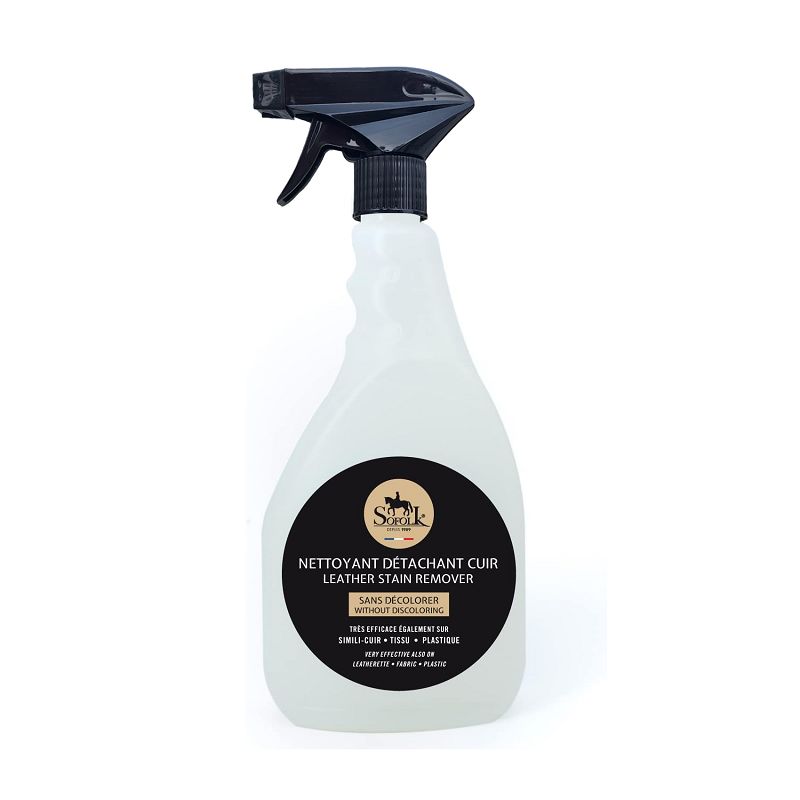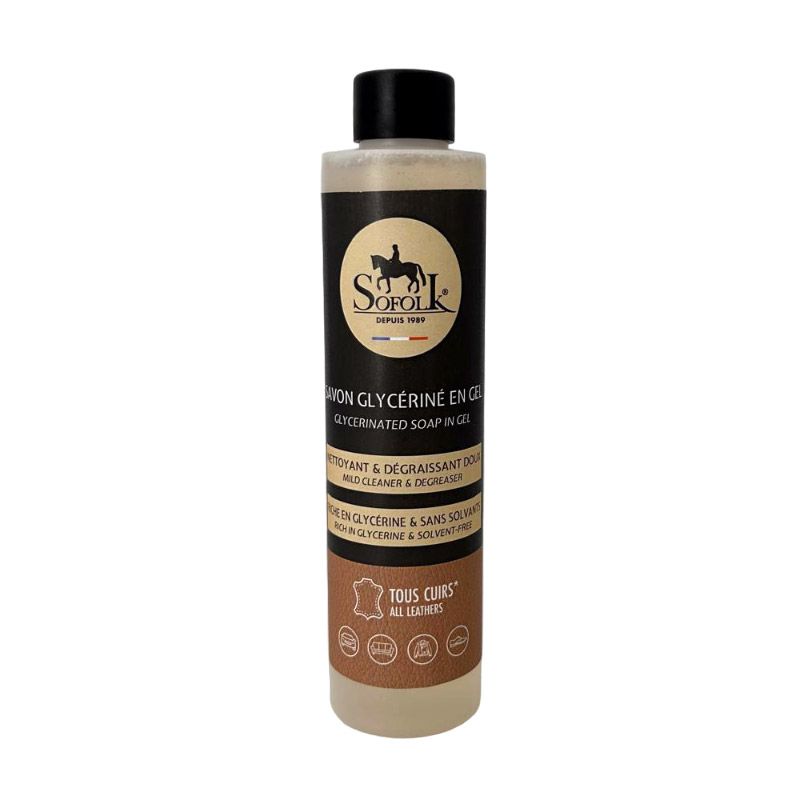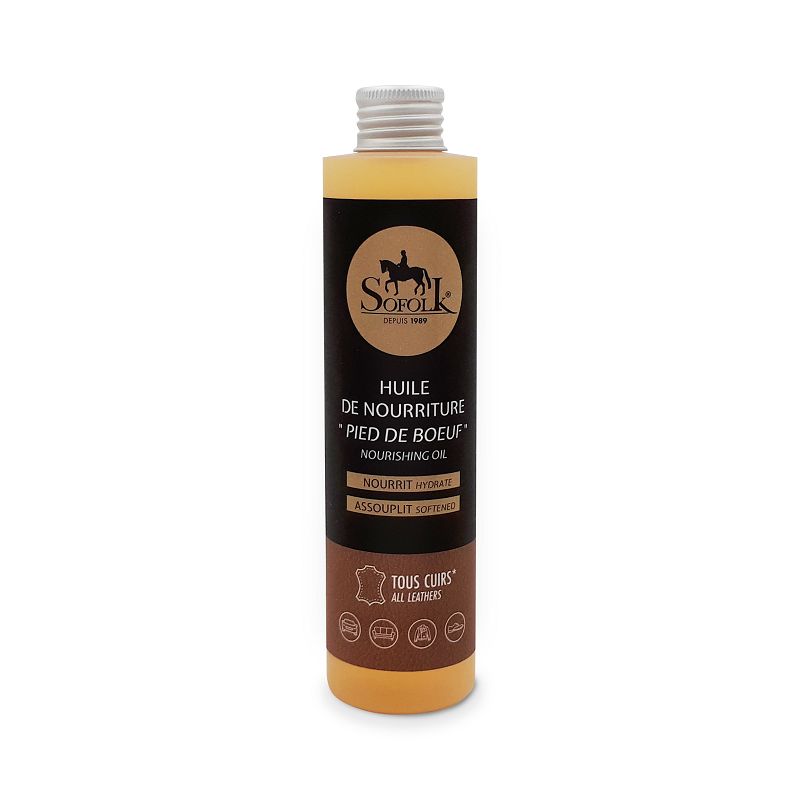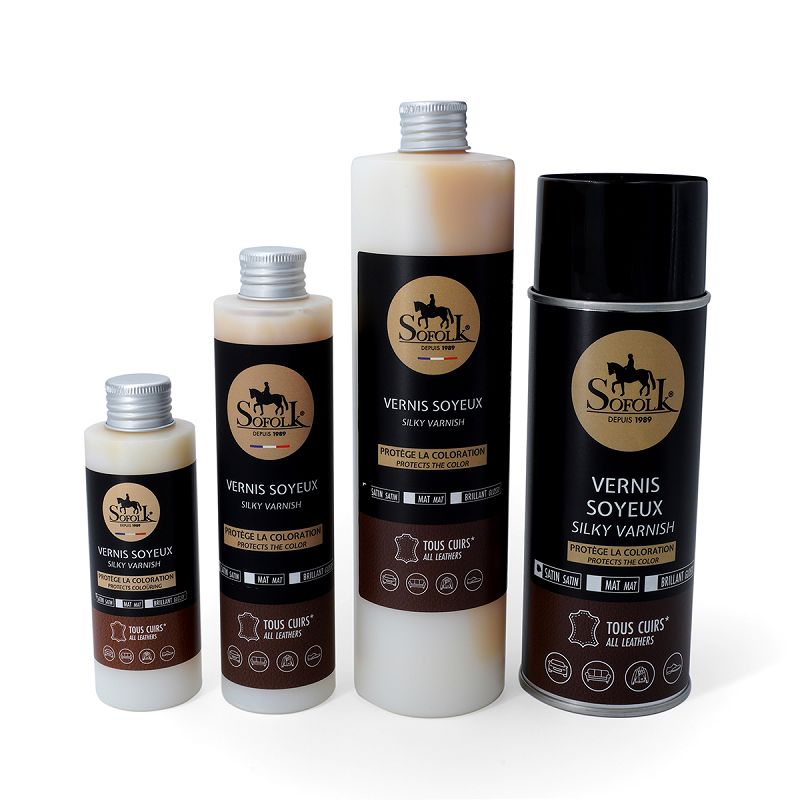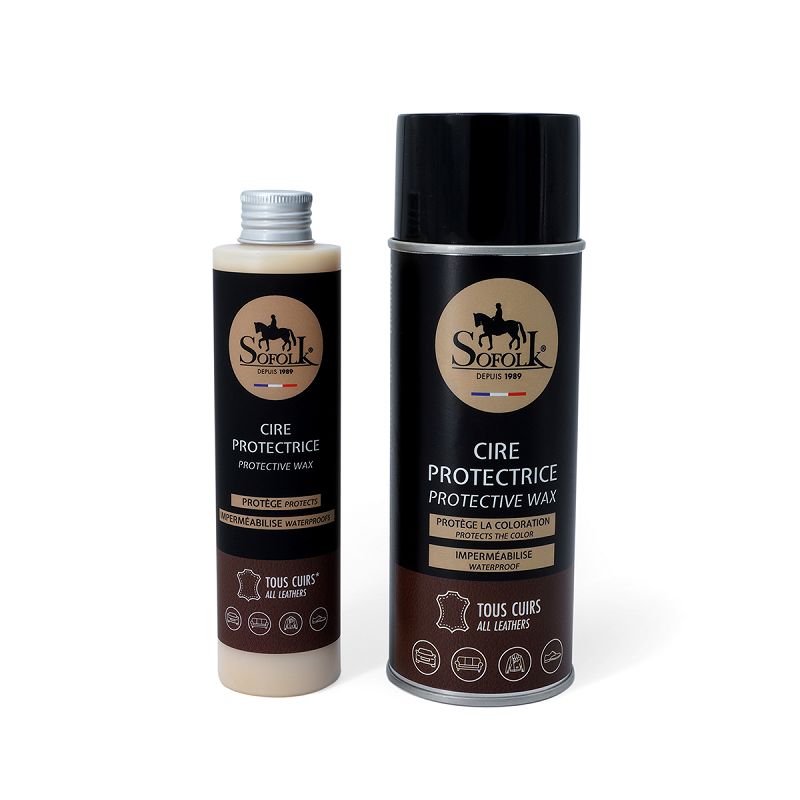LEATHER CARE
Why Maintain Leather?
Leather is prized for its durability, timeless elegance, and ability to improve with age. However, to preserve its aesthetic qualities and robustness, regular maintenance is crucial. Here’s why maintaining leather is essential:
- Preservation of Durability
Leather is a natural material that can dry out, crack, or fade if not properly maintained. Using suitable maintenance products helps keep the leather supple, prevent cracks, and thus extend its lifespan. - Maintenance of Aesthetic Appearance
Leather does not always age gracefully. Without maintenance, it can lose its shine, suppleness, and even its color. Regular care, such as cleaning and applying nourishing creams, helps maintain the original color and texture, ensuring your leather items remain beautiful and attractive. - Protection Against External Aggressions
Leather items such as armchairs, car seats, or shoes are often exposed to various elements like moisture, dirt, UV rays, and chemicals. Proper maintenance creates a protective barrier, preventing moisture absorption and sun-induced fading, while making it easier to clean stains and dirt. - Value Enhancement
Well-maintained leather items not only retain their functionality and beauty but can also increase in value over time. This is especially true for collectible items, furniture, and high-end fashion accessories. - Increased Comfort
Unmaintained leather can become stiff and uncomfortable. By regularly applying moisturizing and softening products, you ensure that your leather items, such as car seats or sofas, remain soft and comfortable to use. - Simplicity of Regular Maintenance
Contrary to what one might think, maintaining leather is not complicated and can be done very quickly if performed regularly. This regular maintenance avoids costly repairs in the long term. You will find more details later in this article on how to maintain your leather. - Reduced Environmental Impact
Maintaining leather prolongs the life of your items, thus reducing the need to replace them frequently. This contributes to more responsible consumption and waste reduction, aligning leather maintenance with more sustainable practices.
Maintaining leather is an essential practice for anyone who owns leather items, whether they are sofas, car seats, clothing, furniture, or shoes.
By preserving the beauty, durability, and functionality of leather, you protect your investment and contribute to a more sustainable use of natural resources. Integrating regular leather maintenance into your routine ensures that this noble material continues to provide comfort and elegance for many years.
The Sofolk Method for Leather Maintenance
For the maintenance and renovation of leather, the SOFOLK method was developed in 1990. It is directly inspired by the work of leather in tanneries since we use the same raw materials (oil, wax, and varnish).
With a few exceptions, our products can be applied to all types of leather (cow, calf, sheep, goat, lamb, pig, suede), and on all types of finishes (aniline, semi-aniline, pigmented).
Which Products for Leather Maintenance?
Discover our range of products specially designed for leather maintenance. They are perfectly suited for smooth or grained leathers, whether for furniture (armchairs, sofas) or automobiles (car seats).
It is essential to carefully follow the instructions and precautions for each maintenance product.
We strongly recommend conducting a preliminary test on a small area before applying the product more broadly.
Effective leather maintenance also relies on applying the products in a specific order. For example, it is crucial to start by cleaning the leather to ensure optimal maintenance. We invite you to consult our detailed leather maintenance guide here.
1- The Sofolk Stain Remover Degreaser Cleaner and Glycerin Soap
Powerful degreasing disinfectant cleaner for leather, skai, fabric, alcantara, plastic, etc.
Ideal for regular cleaning of your sofa, car, shoes, etc.
Extracts ingrained dirt with the help of a microfiber cloth without discoloring the material
Gentle degreasing cleaner for leather
Soap rich in glycerin, ideal for cleaning your sofas, armchairs, upholstery (equestrian, auto-moto-boat), shoes, boots
Low foaming and economical
No risk of leather discoloration
The Sofolk Stain Remover Degreaser Cleaner is specially formulated for deep cleaning. It removes stains, dirt, and grease residues that can accumulate on leather over time. Unlike ordinary cleaners, it eliminates even the most stubborn stains, such as certain ink stains.
The Glycerin Soap is a gentle and less aggressive cleaner. It is ideal for those who clean their leather 1 to 2 times a month.
Tips for Optimal Maintenance
- Preliminary Test: Always perform a test on a small discreet area to check the product's compatibility with your leather.
- Frequency: Regularly clean the leather, especially frequently used surfaces such as car seats or armchairs.
- Product Combination: After cleaning, apply a nourishing product like SOFOLK NOURISHING OIL to restore the leather's hydration and suppleness.
2- The Nourishing Oil “Pied de boeuf”
Nourishes, softens, and waterproofs leather, including cracked leather
Restores leather's resistance to stretching and tearing
With each applied tension, leather consumes a small amount of the oil initially incorporated by the tanner or leather dresser. Without this incorporation, the leather would be completely rigid.
Only specialized oils, such as Sofolk Nourishing Oil, are capable of deeply penetrating the leather fibers. By doing so, it restores (or maintains) the leather's suppleness and resistance, and prevents the premature appearance of cracks, fissures, or even tears.
In summary, hydrating your leather helps maintain the interior of the leather.
Advice: Avoid using leather milks and creams in general. While their application may offer an impeccable and immediately satisfying appearance, these products often remain on the surface, or worse, they can clog the leather in the medium term.
When maintaining leather, the hydration process is generally performed right after cleaning.
3- The Protective Wax and Silky Varnish
Gives the leather a silky touch. Replaces the original varnish destroyed by friction
Protects the color and grain of the leather by adding a colorless wear layer
Prevents premature clogging of the leather
Finishes: GLOSSY, SATIN, or MATTE
Protects and waterproofs the leather grain
Provides a candle-like touch characteristic of fine leathers
Satin finish only
Originally, all leathers are protected by a finishing varnish (matte, satin, or glossy). Over time and with repeated friction, this protection wears off, so it is necessary to renew it at least once a year. The Protective Wax and the Protective Silky Varnish are designed to protect the coloring while allowing the leather to breathe.
What is the difference between Protective Wax and Silky Varnish?
They are two methods to protect your leathers against time, UV rays, scratches, etc. Each has its advantages:
Protective Wax offers a very warm "candle" touch and a particularly pleasant comfort, without a greasy appearance. It is most often used on fine patinated leathers such as club chairs, Chesterfields, or even leather goods, etc. For a refined satin finish.
Silky Varnish needs to be renewed less often and allows for 3 types of finishes: matte, glossy, or satin. It is perfect for automobiles, for example.
Advice: for maximum protection without compromising comfort, apply the varnish and complete with a wax treatment!
Choose the type of maintenance you want for your leather:
How to Maintain Leather? A Step-by-Step Guide
Properly maintaining leather is essential to preserve its beauty and durability. Here is a detailed step-by-step guide to help you keep the leather of your sofas and car interior in perfect condition.
Step 1: Preparing the Materials
Necessary Materials:
- Soft, clean cloths
- Non-abrasive sponge
- Soft-bristled brush
- Specific leather cleaner (such as Sofolk Stain Remover and Degreaser Cleaner)
- Leather nourishing product (such as Sofolk Nourishing Oil)
- Leather protective product (such as Sofolk Silky Varnish)
Instructions:
- Gather all the necessary products and tools.
- Ensure the workspace is clean and well-ventilated.
Step 2: Cleaning the Leather
Objective: Remove dirt, stains, and surface residues.
Procedure:
- Dusting :
- Use a dry cloth to remove dust and surface particles.
- Applying the Cleaner :
- Shake the cleaner bottle.
- Spray on the surface or soak a cloth or sponge with the cleaner.
- Apply to the leather in circular motions, focusing on stained areas.
- Wiping :
- Wipe off the excess cleaner with a clean, dry cloth.
- Drying :
- Let the leather air dry, away from direct heat.
Step 3: Nourishing the Leather
Objective: Maintain suppleness and prevent cracking.
Procedure:
- Applying Sofolk Nourishing Oil :
- Use a clean washcloth to apply the oil.
- Gently massage the leather, ensuring the oil penetrates the fibers well.
- Penetration :
- Allow the oil to penetrate, which may take several hours depending on the leather's condition. Some leathers require several hours. Apply the product in the evening and let it work overnight.
- Wiping :
- Wipe off the excess oil with a clean cloth once the leather is dry.
Step 4: Leather Protection
Objective: Create a barrier against stains and friction.
Procedure:
- Application of the Protective Varnish:
- Using a pre-moistened sponge, apply the product to the leather.
- Ensure to cover the entire surface for maximum protection.
- Drying:
- Let the leather dry completely before using it.
Step 5: Regular Maintenance
Objective: Maintain leather quality in the long term.
Procedure:
- Frequent Dusting:
- Regularly wipe with a dry cloth to remove dust.
- Periodic Cleaning:
- Clean the leather every 3 to 6 months depending on its use.
- Regular Nourishing:
- Apply a nourishing product every 6 months to maintain suppleness.
Additional Tips
- Preliminary Test: Always test products on a small hidden area to check compatibility.
- Avoid Direct Exposure: Protect leather from direct sunlight and heat sources to prevent drying.
- Storage: Store maintenance products in a cool, dry place, out of reach of children.
By following these steps, you can ensure comprehensive and effective maintenance of your leather items. This will preserve their natural beauty, suppleness, and longevity while protecting them from future damage.
Different Types of Leather and Their Maintenance Specifics
Each type of leather requires specific care to maintain its aesthetic qualities and durability. By using appropriate products and techniques, you can extend the life of your leather items and preserve their natural beauty.
Here is an overview of the main types of leather and specific care tips for them:
1. Smooth or Grained Leather
Characteristics:
- Uniform and smooth surface
- The most widely used leather: sofas, car seats, furniture, clothing, and accessories
Maintenance:
- Cleaning: Use a soft cloth and a suitable cleaner such as Sofolk Stain Remover and Degreaser Cleaner or Glycerin Soap
- Nourishing: Regularly apply a nourishing lotion to maintain suppleness, such as Sofolk Nourishing Oil
- Protection: Use a leather protective varnish to prevent stains and wear, such as Silky Varnish or Sofolk Protective Wax
2. Aniline Leather
Characteristics:
- Dyed with soluble dyes
- Natural appearance with visible marks
Maintenance:
- Cleaning: Use a gentle cleaner and avoid excess water like Sofolk Glycerin Soap.
- Nourishing: Apply a specific oil for aniline leather to maintain suppleness, such as Sofolk Nourishing Oil.
- Protection: Apply a protective product to prevent stains, such as Sofolk Protective Wax.
3. Pigmented Leather
Characteristics:
- Covered with a layer of pigment
- More uniform and resistant surface
Maintenance:
- Cleaning: Clean with a product suitable for pigmented leather such as Sofolk Stain Remover and Degreaser Cleaner or Glycerin Soap.
- Nourishing: Use a specific nourishing cream such as Sofolk Nourishing Oil.
- Protection: Apply a leather protector to prevent discoloration, such as Silky Varnish or Sofolk Protective Wax.
4. Oiled Leather
Characteristics:
- Treated with oil or wax
- Supple and shiny texture
Maintenance:
- Cleaning: Use a dry or slightly damp cloth.
- Nourishing: Apply oil for oiled leather to maintain its oily appearance. Sofolk Nourishing Oil is perfectly suitable.
- Protection: It is not possible to protect oiled leather, as the oil prevents any product from adhering...
5. Suede Leather
Characteristics:
- Soft and fuzzy surface
- Matte appearance
Maintenance:
- Cleaning: Use a suede leather brush and a specific cleaner. Sofolk Stain Remover is ideal.
- Nourishing: It is not possible to nourish suede leather. Applying a greasy substance will cause stains that are difficult to remove.
- Protection: Use a waterproof spray to protect against water, oil, and stains.
6. Velvet Leather
Characteristics:
- Soft and textured surface
- Luxurious appearance
Maintenance:
- Cleaning: Brush regularly to remove dust. Sofolk Stain Remover is ideal.
- Nourishing: It is not possible to nourish velvet leather. Applying a greasy product will cause stains that are difficult to remove.
- Protection: Use a waterproof spray to protect against water, oil, and stains.
7. Nubuck Leather
Characteristics:
- Slightly sanded surface
- Velvety texture
Maintenance:
- Cleaning: Use a special nubuck eraser and a suitable cleaner. Sofolk Stain Remover is ideal.
- Nourishing: It is not possible to nourish nubuck leather. Applying a greasy product will cause stains that are difficult to remove.
- Protection: Waterproof with a suitable spray.
8. Suede
Characteristics:
- Soft and flexible appearance
- Velvety and delicate surface
- It is the flesh side of the leather (reverse leather)
Maintenance:
- Cleaning: Gently brush with a suede brush. Sofolk Stain Remover will also help remove stains.
- Nourishing: It is not possible to nourish nubuck leather. Applying a greasy product will cause stains that are difficult to remove.
- Protection: Apply a waterproof spray against water and stains.
9. Patent Leather
Characteristics:
- Shiny and smooth surface
- Glossy appearance
Maintenance:
- Cleaning: Wipe with a soft cloth and a bit of soapy water. Our Glycerin Soap is ideal.
- Nourishing: No nourishing, the varnish completely waterproofs the leather.
- Protection: Wipe regularly to maintain shine.
10. Exotic Leather
Characteristics:
- From exotic skins (snake, crocodile, etc.)
- Unique textures and patterns
Maintenance:
- Cleaning: Use a soft cloth and products suitable for exotic leathers.
- Nourishing: Apply specific nourishing products.
- Protection: Use a protective spray to maintain the natural appearance.
What Not to Do When Maintaining Your Leather
Maintaining leather requires special care to preserve its beauty and longevity. Here are the mistakes to absolutely avoid when caring for your leather items:
- Avoid harsh chemicals
Never use standard household cleaners, bleach, or solvents on leather. These products can damage the surface, cause discoloration, and make the leather stiff or brittle. - Do not use excessive water
Excessive water can damage leather by penetrating its fibers, causing stains, mold, or material deformation. Use a slightly damp cloth instead of a wet one.
- Avoid direct heat sources
Never place your leather items near radiators, fireplaces, or in direct sunlight. Direct heat can dry out the leather, leading to cracks and loss of suppleness. If your leather gets too wet by accident, try to absorb as much as possible with a lint-free cloth or paper towel, and then let your leather dry naturally.
- Do not skip the preliminary test
Before applying a new maintenance product, avoid applying it directly to the entire surface. Always perform a test on a small hidden area to check the product’s compatibility with the leather.
- Avoid non-specific Milks, Creams, Oils, and Fats
Do not use baby milk or creams. Also, oils or fats that are not specifically formulated for leather should be avoided. They can leave sticky residues, attract dirt, and clog the leather’s pores, damaging its appearance and texture.
- Do not scrub vigorously
Avoid scrubbing the leather too hard during cleaning, especially with abrasive brushes or sponges. This can damage the protective varnish at best, and the leather’s surface and pigmentation at worst. You also risk causing scratches and altering the leather’s finish.
- Do not use Shoe Polish on other leather items
Shoe polish is specifically designed for certain types of shoe leather and may contain dyes or chemicals unsuitable for other leather items, such as furniture or clothing. Leather on sofas and car seats are also subject to this restriction.
- Avoid using plastic bags for storage
Never store your leather items in plastic bags. Leather needs to breathe, and plastic can trap moisture, leading to mold and material deterioration. - Do not ignore regular maintenance
Avoid neglecting the regular maintenance of your leather items. The accumulation of dirt and dust can damage the surface and reduce the leather’s durability. Periodic maintenance is essential to maintain its shine and suppleness.
By avoiding these common mistakes, you can extend the life of your leather items and maintain their appearance and functionality. Always use products specifically designed for leather and follow good maintenance practices to preserve the quality of this valuable material.
3 essential products for professional leather care
cleans, protects, and hydrates leather
prevents the appearance of cracks
4 essential products to care for your sofa, armchair, jackets and leather goods
2 formats to choose from: 4x 200ml or 4x 500ml
Special offer until 31/12/2023
4 essential products for good vehicle maintenance
2 formats to choose from: 4x 200ml or 4x 500ml
Ideal for the care of leather and fabrics
Water and oil no longer penetrate. Stains no longer adhere
Duration of action: 6 to 12 months
Based on nanoparticles
FREQUENTLY ASKED QUESTIONS
Do I risk staining my clothes once the Nourishing Oil is applied?
The oil penetrates deeply into the leather and never comes out. The penetration of the oil can take from 5 minutes to several days depending on the saturation level of the leather fibers. If necessary, wipe off the excess product with a paper towel.
Does the Nourishing Oil stain the leather?
Some colors will be slightly darker (as if the leather had been wet). The leather will regain its original color after the product has completely infiltrated.
When and how should I nourish my leather?
Apply the Nourishing Oil at least once a year, and 3 to 4 times a year on highly used areas, such as shoes, seats and armrests of a sofa, or the driver's seat of a car. The product is ideally applied using a washcloth while massaging the leather.
For better penetration, it is recommended to apply the Nourishing Oil BEFORE the Sofolk Silky Varnish.
The nourishing oil should also be applied after a recoloring or a leather repair (about 30 days later)












